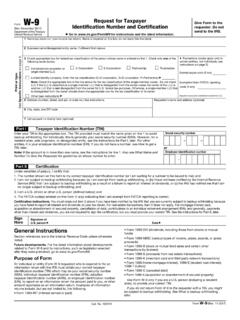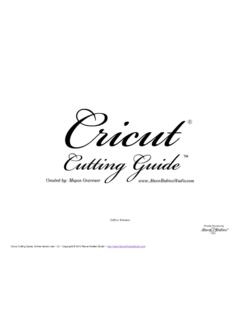Transcription of Guideline on the evaluation of anticancer medicinal ...
1 30 Churchill Place Canary Wharf London E14 5EU United Kingdom An agency of the European Union Telephone +44 (0)20 3660 6000 Facsimile +44 (0)20 3660 5555 Send a question via our website European Medicines Agency, 2017 . Reproduction is authorised provided the source is acknowledged. 22 September 2017 EMA/CHMP/205/95 Committee for medicinal Products for Human Use (CHMP) Guideline on the evaluation of anticancer medicinal products in man Draft agreed by Oncology Working Party November 2015 Adopted by CHMP for release for consultation 25 February 2016 Start of public consultation 15 March 2016 End of consultation (deadline for comments) 15 September 2016 Adopted by Oncology Working Party April 2017 Adopted by CHMP 22 September 2017 Date of coming into effect 01 April 2018 This Guideline replaces Guideline on the evaluation of anticancer medicinal products in man' EMA/CHMP/205/95 Rev 4 Keywords Cancer, malignancy, biomarker, targeted drugs, pharmacogenomics Guideline on the evaluation of anticancer medicinal products in man EMA/CHMP/205/95 Page 2/43 Guideline on the evaluation of anticancer medicinal products in man Table of contents Executi ve summary.
2 4 1. Background .. 5 2. Scope .. 5 3. Legal basis .. 6 4. Pharmacokinetics .. 6 5. Biomarkers .. 7 6. Exploratory studi es .. 8 Cytotoxic compounds .. 8 Phase I, single age nt do se and schedule finding trials .. 9 Phase II, single age nt therapeutic exploratory studies .. 10 Non-cyt otoxic compo unds .. 11 Phase I, single age nt do se and schedule finding trials .. 12 Phase II, single age nt therapeutic exploratory studies .. 14 Monoc lonal antibodies (MoAb) and immune-modulating compounds .. 16 Monoc lonal antibo dies .. 16 Immune-modulating compounds including tumour v accines .. 16 Combination t herapy studies .. 18 Combining conventional cytotoxic compounds .. 18 Combinations involving a non-cyt otoxic drug .. 18 7. Phase III, confirmatory trials .. 20 Design .. 21 Patient population .. 21 Reference therapy .. 22 Cross-over .. 23 Randomisati on and blinding .. 23 Endpoints.
3 23 Treatment administered with curative intent .. 25 Reduced or similar toxicity expe cted .. 26 Increased toxicity 26 Major increas e in t oxicity expected .. 26 Treatment administered with the intent to achieve long-term disease control .. 26 Reduced or similar toxicity expe cted .. 27 Increased toxicity 27 Major increas e in t oxicity expected .. 27 Palliative therapy .. 27 Special cons iderations .. 28 Haematopoietic stem cell transplantation, methodological considerations .. 28 (Neo)adj uvant therapy .. 28 Guideline on the evaluation of anticancer medicinal products in man EMA/CHMP/205/95 Page 3/43 Dr ug resistance modifiers, c hemoprot ective age nts and radio/chemo sensitizers .. 29 Tumour prevention .. 29 Methodolog ical considerations .. 29 Adaptive design .. 30 Interim anal yses.
4 30 Time to event analyses and assessment of r esponse and prog ression .. 30 Non-inf eriority studies .. 31 Analyses based on a grouping of pati ents on an outcome of treat ment .. 31 Studies in small study populations , very rare tumours .. 31 Use of external control .. 32 Special populations .. 32 Elde rly and frail pati ents .. 32 Children .. 33 Gender .. 33 Patients with i mpaired organ function .. 33 8. Safety .. 33 Basic concepts .. 33 Safety in the oncology context .. 34 Study design from a safety perspective .. 34 Safety data collection, analysis and reporting .. 36 Laboratory abnormalities .. 38 Safety issues related to radiation therapy .. 38 Using patient reported outcomes in the safety assessment .. 39 Safety reporting in special populations and pharmacogenomics .. 39 Presentation of adverse drug reactions in the product information .. 39 Definitions and abbreviations .. 41 Guideline on the evaluation of anticancer medicinal products in man EMA/CHMP/205/95 Page 4/43 Exec utive summary The purpose of this Guideline is to provide guidance on all stages of clinical drug development for the treatment of malignancies, including drug resistance modifiers or normal tissue protective compounds.
5 Supportive measures such as anti-emetics and haematopoietic growth factors, however, are covered by separate guidelines. Alongside conventional aims such as defining the proper dose(s) and schedule(s), the importance of identifying a target population with optimised benefit risk is emphasised in Section 6: Exploratory Studies. Guidance is also provided on combination studies. Combinations of drugs with minimal activity as monotherapy, but synergistic effects when combined, as well as combinations of conventional cytotoxics, are also discussed. Convincingly demonstrated favourable effects on overall survival (OS) are from both a clinical and methodological perspective the most persuasive outcome of a clinical trial. Prolonged progression-free or disease-free survival (PFS/DFS), however, are in most cases as such considered relevant measures of patients benefit, but the magnitude of the treatment effect should be sufficiently large to outbalance toxicity and tolerability problems.
6 In order to capture possible negative effects on the activity of next-line therapies and also treatment related fatalities, informative data on overall survival compatible with a trend towards favourable outcome are normally expected at time of submission. This has consequences with respect to interim analyses, other than for futility, and cross-over, which thus should be undertaken only when available survival data provide the information needed for a proper evaluation of benefit/risk. An assessment of benefit/risk should encompass all relevant data on efficacy and safety, also taking into account uncertainties as well as external data of relevance in relation to the experimental compound and the disease to be treated. Therefore no precise definition of trend towards favourable effects on survival or reasonably excluding negative effects on OS is given in this document. If a major increase in toxicity is foreseeable (see section 7), it is recommended that confirmatory studies are undertaken with the aim to show an OS benefit.
7 It is also acknowledged that improved safety without loss in efficacy may constitute tangible aims and the design of non-inferiority efficacy studies are discussed in The requirements of the characterisation of the safety profile have changed with the emergence of molecularly targeted agents (MTAs), immunomodulating drugs and other non-cytotoxic agents. These types of agents may have other types of toxicity and are often dosed differently compared to conventional chemotherapy. The dose-finding process and concepts such as dose limiting toxicity (DLT) may therefore need to be addressed differently than for standard cytotoxic agents. This is discussed in section Furthermore, cumulative incidences of adverse events by toxicity grade alone are not sufficient to characterise the toxicity profile. The impact of an adverse drug reaction (ADR) on the benefit-risk balance may for example differ importantly depending on how the incidence, prevalence and severity change with time on treatment, and on the possibility to alleviate the ADR by dose reduction or interruption.
8 This is addressed in section 8. In section 9, definitions and abbreviations used in this Guideline are summarised. Appendix 1 provides methodological guidance on the use of progression-free survival (PFS) as endpoint in confirmatory studies. Appendix 2 focuses on the use of patient reported outcome (PRO) measures and health-related quality of life (HRQoL) from a regulatory perspective. A revised paediatric Guideline is also foreseen as Appendix 3 and Appendix 4 is dedicated to condition-specific guidance. Guideline on the evaluation of anticancer medicinal products in man EMA/CHMP/205/95 Page 5/43 1. Background The Guideline on anticancer medicinal products adopted in 1996, and revised in 2001 and 2003, focused on conventional cytotoxic compounds. In 2005, a major revision was undertaken, aiming at covering non-cytotoxic compounds, to expand on the sections on exploratory trials and to provide more guidance with respect to methodological issues.
9 Later, there followed an appendix on methodological issues related to the use of PFS and in early 2010 an appendix on haematological malignancies followed. The main Guideline was subsequently updated in line with these appendices, with regard to confirmatory studies based on aims of therapy and relative toxicity, while the section on condition specific guidance was expanded and placed in a separate Appendix 4. Since then a new Appendix 2 has been adopted, concerned with patient reported outcomes and health-related quality of life. The purpose of the 5th revision of the main Guideline is to address current changes in the therapeutic landscape that affect the requirements with regard to collection and reporting of safety data in order to inform the benefit-risk evaluation , including a need for more differentiated and detailed safety data presentation. 2. Scope Whilst the thrust of a regulatory Guideline should be on confirmatory studies, the aim of this Guideline is also to underline the importance of exploratory studies in order to identify the most appropriate target population in addition to the usual aims: to define dose, schedule, tumour type and line of therapy.
10 The role of biomarkers to achieve these objectives is also further emphasised in this revised Guideline . There are numerous possible ways to classify anti-cancer drugs such as direct anti-tumoural vs. indirect anti-tumoural, or based on pharmacology or molecular target ( hormones, immune modulators, nuclear-targeting, signal-transduction targeting, etc.). As this document is meant to provide guidance on clinical drug development, the aim has been to classify compounds according to reasonable designs of exploratory studies, cytotoxic compounds where toxicity and objective response rate (ORR) are considered suitable markers of activity in dose finding studies vs. non-cytotoxic compounds where ORR and/or toxicity may not serve this purpose. A very large number of anti-cancer compounds have been and currently are under development. Only a minority, however, have completed the clinical development and obtained a marketing authorisation, due to poor activity or evidence of a detrimental safety profile.













